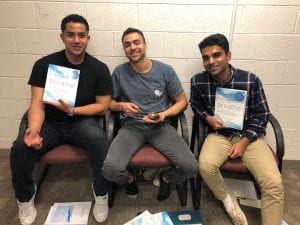For its entire 8-week duration, our project was split into two objectives. The first objective was to implement the Learning to Breathe mindfulness curriculum we received training in to the faculty and staff of refugee community centers in Athens. The purpose of this objective was to establish mindfulness-trained community center care-providers who will use the tools of mindfulness at their disposal, and in ways most conducive to their adolescent populations. We expect that adolescents exposed to the curriculum will be more likely than those not to experience the many benefits of Learning to Breathe, which leads to our overarching goal of improved menta health for child refugees in Athens. In carrying out this first objective, the three of us would hold weekly meetings with the staff of Velos Youth Center, in which we would teach the mindfulness curriculum as well as hear their feedback on what methods would be most appropriate for the children. Each session would normally consist of guided meditation practices, group activities, brainstorming, and open discussions. A detailed lesson outline for each session that was created by the three of us was provided to the Velos faculty for their future use with the children. By helping to heal trauma and increase compassion, perhaps mindfulness intervention can cut off potentially violent cycles and can be considered an investment in humanity.
The second objective of our project was to provide a survey of the prevalence of traumatic experiences and ecological stressors among child migrants. The purpose of this objective was to publish much-needed data on adolescent refugee mental health in order for the international aid community to respond to the refugee crisis with positive, evidence-based interventions. Through the non-profit organization Humanity Crew that we worked directly with in Athens, we were able to come into contact with several different refugee community centers. Among these centers were Safe Place International, a haven for LGBTQ+ refugees, and the Hellenic Red Cross, a hub for child refuges and families alike. At the centers, we were able to carry out our surveys, collecting data on more than 50 adolescent refugees from Iran, Syria, Afghanistan, Iraq, and other countries as well. The procedure for carrying out our surveys was broken down into three segments. We also worked with multiple translators that spoke languages incudi Farsi, Dari, French, Arabic, and others. A main segment of this objective included speaking to the child refugees, getting to know them, and building a comfortable relationship of trust. The second segment consisted of having there legal guardians sign consent forms after being explained the research survey in thorough detail, followed by explaining to the actual participant the survey details in the format of a child assent form. The third segment consisted of the translators and ourselves carrying out the survey with the participants, explaining each question in detail and making sure there was no confusion or discomfort at any time.
